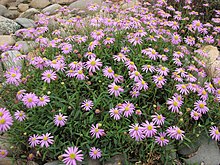Brachyscome
| Brachyscome | |
|---|---|

| |
| Brachyscome graminea | |
| Scientific classification | |
| Kingdom: | Plantae |
| Clade: | Tracheophytes |
| Clade: | Angiosperms |
| Clade: | Eudicots |
| Clade: | Asterids |
| Order: | Asterales |
| Family: | Asteraceae |
| Subfamily: | Asteroideae |
| Tribe: | Astereae |
| Subtribe: | Brachyscominae |
| Genus: | Brachyscome Cass. |
| Species | |
Brachyscome is a genus of flowering plants in the family Asteraceae. Most are endemic to Australia, and a few occur in New Zealand and New Guinea.[1]
Name
[edit]The genus name is spelled Brachycome by some authors. Henri Cassini published the name Brachyscome in 1816, forming it from the classical Greek brachys ("short") and kome ("hair"), a reference to the very short pappus bristles. Because the combining form of brachys in Greek compound words is brachy-, Cassini later corrected the spelling to Brachycome. Australian taxonomists still debate whether Cassini's corrected spelling is admissible under the rules of botanical nomenclature. A proposal to conserve Brachycome was rejected in 1993 by the Committee for Spermatophyta.[2]
Genetics
[edit]One of the annual plains species, Brachyscome dichromosomatica, is remarkable for its low chromosome count. In this species n=2, though some plants have 1, 2 or 3 additional large B chromosomes.[3] The genus has an unusually large range of chromosome counts, from n=2 to n=18.[4]
Description
[edit]These are annual and perennial herbs and small shrubs. Species have a basal rosette of leaves and/or leaves alternately arranged on the stem. The blades are entire or divided. The flower heads are solitary or borne in small corymbs. The head has a row of ray florets in shades of white, blue, pink, or mauve, and yellow disc florets.[1]
Fruit
[edit]The genus is distinguished from other genera in tribe Astereae mainly by the structure of the fruit. These achenes or cypselas are roughly club-shaped but usually incurved and flattened. They often have a membranous rim or wing around the edge that is sometimes wavy or fringed. The pappus is less than one millimeter long in most species.[5]
Habitat
[edit]Brachyscome species are found in a wide range of habitats. They occupy rainy coastal and mountainous regions as well as dry central Australia.[4]
Cultivation
[edit]Some Brachyscome species, notably Brachyscome iberidifolia (Swan river daisy), are popular as easily cultivated ornamental plants for flower gardens, and many cultivars are bred for their form, foliage, and flowers.[6]
Species
[edit]There are between 65 and 80 species in the genus.[1][4][7]
Species include:
- Brachyscome aculeata – hill daisy
- Brachyscome ascendens
- Brachyscome basaltica – swamp daisy
- Brachyscome chrysoglossa - yellow-tongue daisy
- Brachyscome ciliaris - variable daisy
- Brachyscome decipiens – field daisy
- Brachyscome dentata
- Brachyscome graminea - stiff daisy, grassland daisy
- Brachyscome iberidifolia - Swan River daisy
- Brachyscome multifida - cut-leaved daisy, rock daisy, Hawkesbury daisy
- Brachyscome nivalis – snow daisy
- Brachyscome scapigera - tufted daisy
- Brachyscome segmentosa - Lord Howe daisy, mountain daisy
References
[edit]- ^ a b c Genus Brachyscome. PlantNet. New South Wales Flora Online. The Royal Botanic Gardens and Domain Trust, Sydney.
- ^ Brummitt, R. K. (1993). Report of the Committee for Spermatophyta: 38. Taxon 42(3), 687-97.
- ^ Carter, C. R. (1978). Taxonomy of the Brachycome lineariloba complex (Asteraceae). Telopea 5, 387-93.
- ^ a b c Watanabe, K., et al. (1999). Chromosomal evolution in the genus Brachyscome (Asteraceae, Astereae): statistical tests regarding correlation between changes in karyotype and habit using phylogenetic information. Journal of Plant Research 112(2), 145-61.
- ^ Everett, J. "Brachycome". In: Harden, G. J. (ed.) Flora of New South Wales volume 3, pages 155-67. University of New South Wales Press. 1992.
- ^ Research Garden. Royal Botanic Gardens, Cranbourne.
- ^ Brachyscome. The Plant List.
Further reading
[edit]- Watanabe, K. and P. S. Short. (1992). Chromosome number determinations in Brachyscome. Muelleria 7, 451–71.
External links
[edit]![]() Media related to Brachyscome at Wikimedia Commons
Media related to Brachyscome at Wikimedia Commons
- Brachyscome species records. FloraBase. Western Australian Herbarium.
Text is available under the CC BY-SA 4.0 license; additional terms may apply.
Images, videos and audio are available under their respective licenses.
